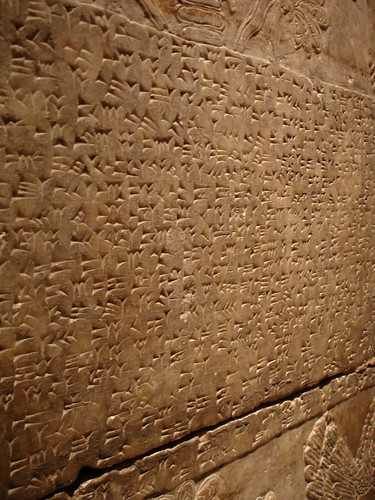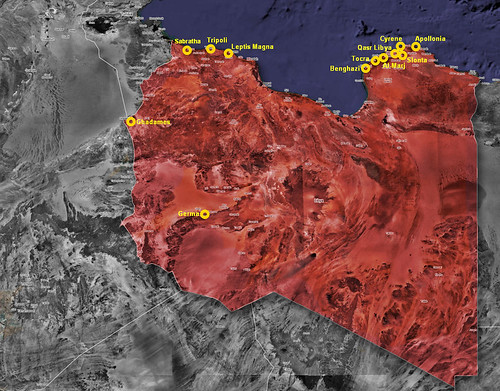Museum of Iraq for the International Museums Day
Published by Pilar Gonzalo on 19 de mayo de 2007 at 0:07. To celebrate the International Museum Day, at lamusediffuse we have started a new Flickr group called Museum of Iraq 2.0 Our goal is sharing photos on Sumerian, Assyrian, Babylonian, Mesopotamia or Iraqi art, artifacts and cultural heritage disseminated in collections from all over the world. We want to create an online reference for all those who love that museum by gathering photos and videos of art and artifacts from Iraq.
To celebrate the International Museum Day, at lamusediffuse we have started a new Flickr group called Museum of Iraq 2.0 Our goal is sharing photos on Sumerian, Assyrian, Babylonian, Mesopotamia or Iraqi art, artifacts and cultural heritage disseminated in collections from all over the world. We want to create an online reference for all those who love that museum by gathering photos and videos of art and artifacts from Iraq.After the Cadlelight Vigil for the Iraq Museum and because today is a day internationally devoted to Universal Heritage, why do not we re-open that wonderful museum, although virtually. If it is not possible in Baghdad, we can do it online from outside. Any volunteer for a Second Life one?
Etiquetas: e-artcasting, International Museum Day, Iraq, Iraq Museum, lamusediffuse, Second Life, SL
Día Internacional de los Museos: Patrimonio ¿Universal?
Published by Pilar Gonzalo on 17 de mayo de 2007 at 19:47. Este año, el Día Internacional de los Museos está dedicado al Patrimonio Universal. Con motivo de esta celebración el Consejo Internacional de Museos (ICOM) recoge en su página web un listado de las actividades que tendrán lugar en todo el mundo. Lo más probable es que, afortunadamente, tu país figure entre los que estén organizando actividades. Pero en e-artcasting queremos subrayar la presencia de "los que no están".
Este año, el Día Internacional de los Museos está dedicado al Patrimonio Universal. Con motivo de esta celebración el Consejo Internacional de Museos (ICOM) recoge en su página web un listado de las actividades que tendrán lugar en todo el mundo. Lo más probable es que, afortunadamente, tu país figure entre los que estén organizando actividades. Pero en e-artcasting queremos subrayar la presencia de "los que no están".Las razones por las cuales ciertos países del mundo no tienen información disponible en internet sobre sus museos y su patrimonio cultural son complejas a la vez que tristes, tal como estamos comprobando en nuestra investigación sobre museos en Libia. Esta falta de presencia en internet provoca que la indiferencia mundial esté encubriendo los saqueos masivos de los que están siendo víctimas ciertas áreas del mundo. e-arcasting colaboró recientemente en la campaña de sensibilización y recuerdo del saqueo al Museo Nacional de Irak y participó activamente en la vigilia celebrada en San Francisco el mes pasado. Sin embargo, muchos son los que están haciendo una tremenda labor por la recuperación de los artefactos robados, como los que ayer y hoy mismo están siendo robados en Irak.
Aunque el blog de Francis Deblauwe, The Irak War and Archaeology Blog, se dejó de editar hace ya casi un año, todavía podréis encontrar en él magníficos recursos y enlaces sobre el tema que esperamos os hagan más conscientes de la gravedad del problema.
SAFE, Saving Antiquities for Everyone, la organización con la que hemos estado colaborando recientemente en la vigilia a la luz de las velas para recordar el saqueo del Museo Nacional de Irak, también publica en su página web interesantísimos recursos y enlaces.
Asimismo, otra página compilatoria de recursos llamada Iraq Museum International, también incluye con interesantes enlaces sobre el tema entre los que destacamos el maravilloso Museum Open Directory.
Pero mientras nosotros estamos aquí tratando de evitar el pillaje y colaborando en la recuperación objetos robados a sus museos, los museos (aquellos en los que la seguridad de sus colecciones no está en inmediato peligro) parecen estar en otros menesteres. Así pues, el debate del papel contemporáneo de los museos en la sociedad tecnológica, la "cultura del espectáculo" y el papel de las tecnologías interactivas en ellos parece seguir siendo controvertido a juzgar por el artículo de Román Gubern, "¿Han desertado las musas de nuestros museos?"
Aunque entendemos que Gubern está dirigiendo sus críticas a aquellos museos cuyos directores parecen preocuparse más de las fiestas y de su propia persona que de los contenidos de sus colecciones y la consolidación de su valor, queremos subrayar que el papel de la tecnología en los museos ha de ser siempre positivo, pues es un instrumento que complementa los objetivos de los propios museos. De hecho, nuestro objetivo fundamental en lamusediffuse es utilizar las tecnologías sociales para hacer la cultura accesible a todo el mundo, ya se trate de un Rembrandt o del último premio Turner.
De modo que ¿por qué no dedicamos este Día Internacional de los Museos a hacer un positivo de estas tecnologías para los museos? El reto que te proponemos es compartir información sobre museos de algún país que no figure en la lista de celebraciones del ICOM. Nosotros hemos empezado con Libia.
Imagen: Duimdog: Jamahiriya Museum en Tripoli, publicada en abril del 2006.
Etiquetas: Africa, Dia Internacional de los Museos, e-artcasting, ICOM, International Museum Day, Irak, lamusediffuse, Libia, Middle East, Museo de Irak, Museos, Patrimonio, Software social
Museums in Libya: Call for Collaboration
Published by Pilar Gonzalo on 15 de mayo de 2007 at 19:27. At e-artcasting we continue involved in a research to make Libyan museums visible online thanks to digital technologies and social software. Although Libya has fantastic museums, they are suffering from a pitiful lack of online visibility. This is something we want to palliate by using the possibilities of Web 2.0 tools and social collaboration.
At e-artcasting we continue involved in a research to make Libyan museums visible online thanks to digital technologies and social software. Although Libya has fantastic museums, they are suffering from a pitiful lack of online visibility. This is something we want to palliate by using the possibilities of Web 2.0 tools and social collaboration.Our project addresses two facts. The first one is the lack of information about museums in Libya available on the websites of related institutions, particularly on the AFRICOM’s one. The second fact is the apparent lack of museum websites in Libya. Thus, our final goal is achieving a reference document on Libyan Museums -focused on the specific example of the Jamahiriya Museum at Tripoli- and made it available online for researchers, professionals and people interested in Museums and Libyan Culture.
Till now and thanks to contributors like you we have been able to locate 12 museums on our map of Libya on the photo. However, we already have 24 museums listed in our Libyan Museums List belonging to our Museums in Libya wiki. Now, we want to populate and polish this information and create an interactive map with all your photos. To achieve it, we need your collaboration.
We would really appreciate if you check the Libyan Museums List to add any additional information you could know on any museum in the list or about anyone still not on it.
We also encourage you to share your photos on Libyan museums in our Flickr group, e-artcasting. We need you tagging photos on museums in Libya with, at least, this information,
- Continent where the museum is
- Country where the museum is
- City, Town, or specific location where the museum is
- Complete name of the museum
- the tag “Museum”
- the tag “Art” (in case of Art Museums)
If you have any video, article or any other kind of information; you can post them here at Ly-Hub, send it to our del.icio.us account with the tagg "for:e_artcasting" or contact us at contact@lamusediffuse.com
Please, help us to spread the word and do not hesitate to make us any question. We are looking forward your collaboration!
Etiquetas: Africa, Heritage, Libya, Museums, Professional, Sociable Museums, Sociable Technologies, Social Software, Web 2.0
Your Photos on Museums: Ile Ife National Museum, Nigeria
Published by Pilar Gonzalo on 12 de mayo de 2007 at 0:54.
You are Sociable Museums' most precious value. Thanks to your emails, comments and contributions Sociable Museums' mission is increasing its diverse outreach.
One of Sociable Museums most active activities is located at the Flickr group. Users are about to contribute 1,000 wonderful and rare photos on art museums from all over the world, so it is hight time for celebration. Today we start a new section named, "Your Photos on Museums" in which we will rescue on weekly basis a selection of your best contributions at our Flickr pool.
For our Grand Opening, this exquisite image of the Ile Ife National Museum (Nigeria) taken in April 1958 and posted by Rabinal, who also shared with us a fragment of The White traveller in Black Africa, by Colin Wills,
The Creation of the World (Yoruba version). The creation of the world took place at Ife. Orafame. The Supreme Being, the Creator, sent Orishala out from heaven to create the world. The way was long and hot, and Orishala rested in a grove of palms. He was thirsty, and he drank palm wine, and fell asleep, a serious dereliction in one with such a high task. Orafame was disappointed. He called another demigod named Oduwa, and sent him forth to carry out the mission. Oduwa did not pause by the way. He took earth, a hen, and a chameleon. The hen spread out the earth and scraped it into a mound, just as you will see her do today. The chameleon moved over the mound, testing it with his light weight, feeling gently with his little feet. His delicate,tremulous movements which you can see today, are a memory of that great task. From the mound grew the Earth. It was there that Orfame set down the first man and woman, and from there stemmed the Yoruba people. The mound still exists; I will show it to you presently, said my guide. Oduwa, naturally, is worshipped by millions of Yoruba. The chameleon is also sacred, and the hen, though eaten, is regarded with great respect and affection. But the strange thing is that Orishala also has his devotees. One might expect them to be the wine-bibbers of the community. On the contrary, they are the teetotallers. When Orishala awoke and found that somebody else had created the world while he slept, he bitterly lamented his failure, and swore never to touch palm wine again. He never did, and neither do any of his followers. His failing remains an example forever, a warning to men of their own frailties.Image: Rabinal: Museum at Ife, posted on September 2006.
Etiquetas: Africa, Art, Flickr, National Museum of Ile Ife, Nigeria, Photos, Sociable Museums, User Generated Content, Web 2.0, Yoruba, Your Photos on Museums
How to know if your museum is Web 2.0
Published by Pilar Gonzalo on 3 de mayo de 2007 at 23:59.- Buy some sticky label paper for printing,
- print the designs listed below,
- match your staff members with their correspondent stickers,
- encourage your staff wearing the stickers with pride
To match your people with their stickers, just follow these guidelines,
For Registrars

If your registrar is really, really cutting-edge, try with this other,

For Curators

If your curator truly loves hanging our with other staff members, try a step forward,

For Educators

If your educator organizes activities other than "for kids,"

For Directors

If your director thinks other than only on fundraising,

For Board Members

If your board members are truly mission-focussed,

Finally, do not forget taking some photos and posting them on your museum blog!
(Thanks to the Tech-CH Blog guys for providing this wonderful tool)
Etiquetas: Blogs, Curators, Directors, e-artcasting, Educators, lamusediffuse, Museums, Professional, Registrars, Sociable Technologies, User Generated Content, Web 2.0
